Find us on Facebook: Cast Iron Canada – https://www.facebook.com/groups/1408817499448631/
Information always changes, and updates are made to this page to reflect – and the original article here was based on the currently known history – it was wrong. The history of “Favorite Stove and Range Co” in Piqua, Ohio has been changed – you can read it all here with evidence to back it all up. “History of Favorite Stove and Range Co”.
If you wish to discuss any information on this page or post any information or pictures you have regarding this maker, please visit the forum @ http://forum.castironcanada.com.
First of all, why this write up? Well, it seems there are certain groups of collectors that consider nearly every Canadian piece a copy of an American piece. While evidence exists that Canadian manufacturers did indeed purchase and use patterns of American companies – they didn’t try to hide the fact. Ghost marks and/or artefacts exist on certain “Good Cheer” products from James Stewart and “Enterprise Foundry” in New Brunswick for example. Griswold’s breakfast skillets are a prime example here, always thought to have come first – and anything from Smart, McClary or Findlay etc, has to be a copy. Yet, nobody to date can provide any proof or evidence of anything so at this point, it’s all propaganda. Does it really matter in the end? Probably not, copying happened from foundry to foundry.
Been spending more time on Chown and Cunningham lately, both men date back to foundries in the 1840’s or earlier so they can’t be classified as strangers in foundry manufacturing. Just haven’t found much information as yet that can be verified. However, some interesting information for you.
In 1891, Chown and Cunningham was sold to Thomas Davidson (Thos Davidson Mfg), it’s looking like C&C went under due to a labor strike. But James Smart Manufacturing Co Ltd bought the cast iron side of the company in 1893 from Thos Davidson Mfg. Smart assumed all trademarks and patterns for the “FAVORITE” line and continued to sell the “FAVORITE” line until Findlay bought it around 1897/1898 as evidenced further below.
So what about the “Favorite” trademark? 9 days after the Davis Trademark of “Favorite” expired – James Smart buys Chown and Cunningham. That’s a big coincidence. Couple of months later, Stanhope Boal in 1893 registers the “Favorite” TM for “Favorite Stove and Range Co”. That wouldn’t be a coincidence. Boal was not on the trademark, it wasn’t his – it was registered in W.C Davis’ name only.
Taken from “Hardware – January 3, 1890”:
Amongst the many such trade marks that we have in mind, and they are legion, there is perhaps no one more familiar and appropriate than that of “The Favorite” as applied to the stoves and ranges manufactured by The Chown & Cunningham Co., of Kingston and Toronto.
This term was adopted about five years ago (1885), and stands emblazoned on a disc with the rays of the rising sun for a back ground The name of the firm encircles the disc, and the whole forms a most striking trade mark which cannot fail to attract attention. The character of their productions is we understand fully in keeping with their name being indeed “favorites” with those who have them in operation.
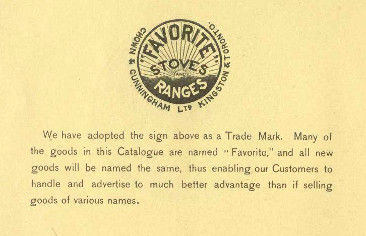
Ok, so Chown and Cunningham had the “Favorite Stove’s and Ranges” trademark with the sunrise logo in Canada but where is this going? Legal or not, Canada and the USA didn’t have to respect each others trademarks. W.C Davis – the owner of the Favorite TM didn’t have any ownership in Favorite Stove Works at that point – and Boal didn’t own the “Favorite” TM. Bear with me.
The next James Smart catalog shows the following, pretty self explanatory – and the “FAVORITE” line of stoves clearly shows the sunrise logo from Chown and Cunningham.
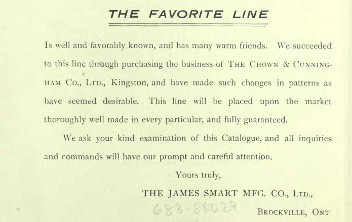
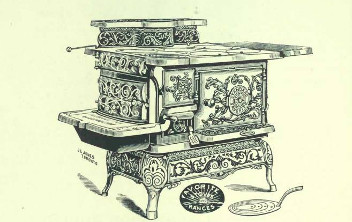
Not finished yet. In Findlay’s 1898 catalog, the “FAVORITE” sunrise logo appears again – and Findlay carried on the Favorite line of stoves and ranges – for how long, I am not sure. More catalogs need to be found, however it seems for a couple of decades from pictures of stoves popping up through google images. There is no evidence past 1897 showing Smart selling the FAVORITE line, so it is safe to assume that all trademarks and patterns were bought by Findlay Brothers out of Carleton Place, Ontario.
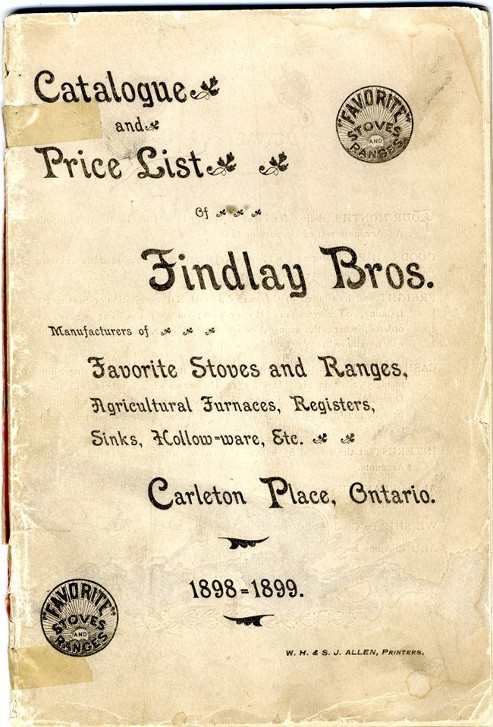
Now where is this information going? There is a link or correlation somewhere between Chown and Cunningham – and “Favorite Stove and Range” in Piqua, Ohia. I am not suggesting anything, stating anything or other – this is just evidence put forward and I’m asking questions.
Certain collectors have stated that there was indeed a trademark lawsuit between “Chown and Cunningham” (C&C) and “Favorite Stove and Range” that C&C lost – perhaps putting the company under. I’m still waiting for anyone to provide proof of that lawsuit, and I haven’t found anything online. Another claim that was made by the same individual is that there exists proof that “Favorite Stove and Range” owned C&C – no evidence to show that. But how would James Smart or Findlay be able to carry on using the “Favorite Stove’s and Range’s” logo if such a lawsuit existed? “Favorite Stove and Range Co” was a new startup – had nothing to do with “Great Western Stove Works” or “Favorite Stove Works”. The company “Favorite Stove and Range” didn’t exist when Chown & Cunningham trademarked the logo in Canada.
One more interesting note – and again, I suggest nothing, this is just evidence that needs to be researched… It’s proven that Smart took over the cast iron side of Chown and Cunningham in 1893, assumed the trademarks, patterns and everything “FAVORITE”.
“Favorite Stove and Range Co” in Piqua, Ohio wasn’t evidenced to make hollow prior to 1916 – although it’s suggested that hollow ware was possibly made before 1916. That is now proven incorrect – they made hollow ware from the beginning. Canada Foundries and Forgings bought James Smart Manufacturing in 1912 and there is no evidence to show they carried on using the original “Diamond G” indicated on the skillet handle below. So, in 1916, the original James Smart “Diamond G” wasn’t used anymore. So how was it possible that “Chown and Cunningham” had a “Favorite Piqua Ware” skillet pattern prior to the Smart takeover in 1893?
The pictures below show a skillet, top and bottom of a Chown and Cunningham made piece – on the handle is the original “Diamond G” pattern from James Smart. Note the “Favorite Piqua Ware” on the bottom of the skillet. If someone can shed some light on this piece, or have other cast iron pieces that are similar – I would love to hear from you. Drop an email with any pictures to admin@castironcanada.com.


Finding “Chown and Cunningham” pieces isn’t easy but there is one clean – albeit small – picture of an original “C&C” skillet. The diamond is zoomed in. Some people see a G but it doesn’t conform to any known G from James Smart Manufacturing. Some see a number 3, some see an “other”.
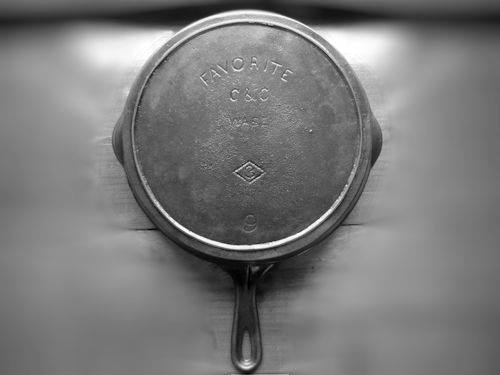
How important is the object inside the Diamond? Apparently, it’s not.

And I’m just going to leave these pictures here. Have a look. The two hatch marks under the handle are evident in the C&C skillets and later Favorite ware skillets produced by Smart with the G on the handle. Compare the Favorite Piqua Ware number 9, that’s a pretty distinct font for a 9, you have to admit.

And this is a close up of that Favorite Piqua Ware skillet. Compare the 9’s, compare the hatch marks under the handle.
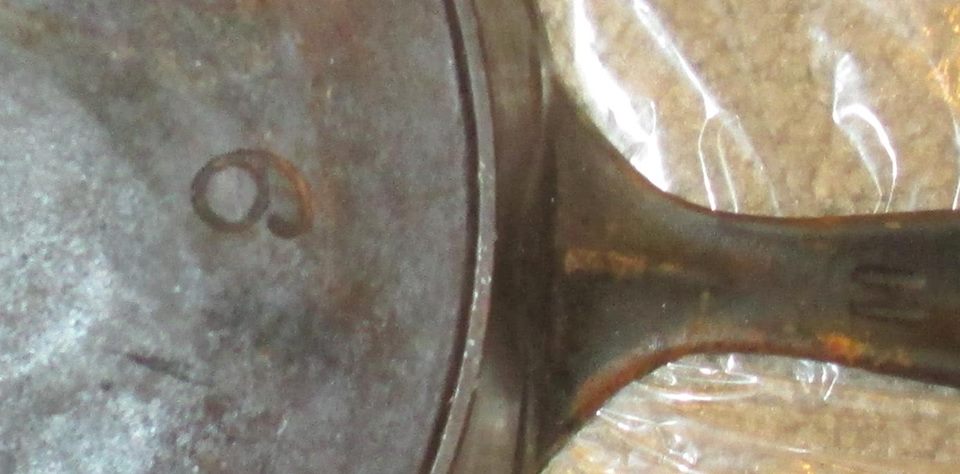

To finish up this article… Through the 1880’s, there were massive labor strikes in foundries throughout Canada and the United States. “Bridge, Beech and Co” for example caused a major upheaval when they locked out workers. It near went country wide – “Bridge, Beech and Co” were trying to get foundries anywhere to take their patterns and keep producing – but once workers in union shops realized they were scabbed patterns from St. Louis, they dropped tools and walked out. Foundries that were struck and boycotted tried desperately to get other foundries to take their patterns – sometimes successful, sometimes not.
I wonder if some of these patterns went cross border – pure speculation on my behalf.
It’s a fascinating history – on both sides of the border.
![]()